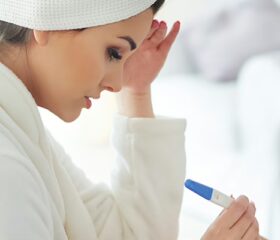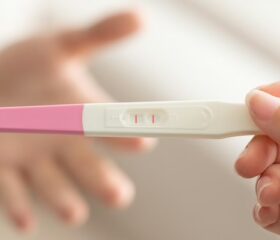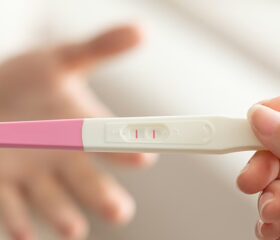7 Signs Ovulation Is Over: Egg Lifespan and Fertile Window
There won’t be any fireworks going off at the end of ovulation, but your body will drop hints that your fertile window is ending. You just have to know what to look for.

Ovulation, the release of an egg from one of your ovaries, marks the peak of your fertile window. Whether you’re trying to conceive, trying to avoid pregnancy, or just want to understand your body better, tracking its start and end can help guide you.
Here’s what you need to know about identifying ovulation and your fertile window.
How long does ovulation last?
Ovulation itself is quite brief: a 12–24-hour period in your menstrual cycle when one of your ovaries releases an egg for fertilization. If your egg doesn’t come in contact with a viable sperm, your fertile period ends, and in 10–14 days, your uterus sheds its lining, which results in the discharge you get during your period. 1 2
If you have a regular cycle, this will happen midway through (e.g., on day 14 of a 28-day cycle). You can use a simple ovulation calculator to get a rough idea of when you’re ovulating based on your cycle length.
When is your fertile window?
Ovulation itself only lasts 12–24 hours. Your fertile window is a broader timeframe that spans several days.
That’s because sperm can survive in your reproductive tract for up to 5 days. 3 This means that having sex in the 5 days leading up to ovulation can still result in pregnancy, as the sperm will potentially be waiting to fertilize your egg once it’s released.
7 signs that ovulation is over
You may assume that you’re done ovulating (and are exiting your fertile window) if your ovulation symptoms ease up or completely stop (e.g., if your ovulation pain goes away). This is true, but only to an extent; your symptoms (or lack thereof) can be a clue, but the signs are not always clear-cut.
Here’s a breakdown of what you may experience in your luteal phase (the time after ovulation, which lasts until your next period): 4
1. Thicker cervical mucus
You may notice that your vaginal discharge varies throughout your cycle.
- Before ovulation: You may produce egg white discharge (clear, slippery, and stretchy mucus) in the 4 days leading up to when you ovulate and the day of ovulation itself. This consistency facilitates sperm movement, and it indicates you’ve hit peak fertility. 5 6
- After ovulation: Your progesterone (hormone) levels rise after ovulation. When this happens, your ovulation discharge changes, with your mucus becoming thicker, stickier, and cloudier (like bubble gum). 7 8 Alternatively, you may produce no discharge at all after you ovulate. 9
2. Higher basal body temperature (BBT)
Some women chart their basal body temperature (BBT), which is the body’s lowest temperature at rest. If you do this consistently every day for a few months, you may notice slight fluctuations throughout your cycle, although this varies heavily from woman to woman and sometimes even from month to month.
- Before ovulation: Your BBT may dip 1–2 days before you ovulate. 10 To track it, you will need to use a basal thermometer with two decimal places that can display the slightest fluctuations.
- After ovulation: BBT tends to rise after ovulation—anywhere from 0.4 to 1 °F (although, again, this is far from universal). It may drop just before you get your next period. 11
This isn’t the most accurate of tests, since many lifestyle factors can affect your temperature, such as sickness, lack of sleep, or smoking and drinking. 12 However, there’s no harm in trying as long as you don’t put too much faith in the results. Never rely on them if you’re trying to avoid pregnancy instead of trying to conceive.
Make sure you take your temperature at the same time every morning before getting out of bed.
3. Lower and firmer cervix
If you’re comfortable checking your cervix (which you should only do with clean hands), you may notice a few differences in it:
- During ovulation: Your cervix gets softer and moves higher up in your vagina when you ovulate, which may make it harder to reach. 13 14
- After ovulation: Your cervix tends to return to a lower, firmer position. (Note that this is a gradual process that can be hard to detect.)
To reiterate, always wash your hands before checking your cervix to avoid introducing bacteria and causing infection. 13
4. Decreased libido
Your sexual desire may fluctuate according to where you are in your cycle:
- Before and during ovulation: Your rising hormones may cause your sex drive to ramp up in the days leading up to and during ovulation. 15
- After ovulation: As your hormone levels shift, you may notice a drop in your sex drive, which is especially true if you’re dealing with anxiety, low energy, and feelings of sadness during the luteal stage (a common experience, although not a universal one). 16
5. No ovulation pain
You may experience a dull or sharp stab of pain—usually on one side of your lower abdomen—in the middle of your cycle. This ovulation pain, also known as mittelschmerz, normally lasts a few hours, but may drag on for up to 48 hours if you’re unlucky. 17
If your pain subsides, it may be a sign you have stopped ovulating. Be aware that your egg is still viable for up to 24 hours afterwards, so you could still be fertile. 6
6. Changes in breast tenderness and other symptoms
You may experience sore breasts and nipples when you’re ovulating due to higher levels of estrogen. However, afterward, when your progesterone levels rise, that may also trigger breast pain. 18
These hormonal fluctuations can cause your breast tenderness to persist or even worsen for a few days after you’re done ovulating.
Other potential physical and emotional signs that you’re past ovulation and in the luteal phase include: 4
- Mood changes
- Bloating
- Skin changes (acne or breakouts)
- Changes in your appetite
Some of these can also be symptoms of ovulation itself (e.g., bloating and changes in your appetite or moods), so it can get a little confusing to distinguish between the two. 19 Your best bet is to track your symptoms over the course of a few months to learn what’s normal for you.
Try using an ovulation tracking app to spot trends in your symptoms
For more clarity on how your symptoms change throughout your cycle, consider using your journal or a fertility tracker app. This can help you better identify any patterns in the distinct stages of your cycle. Ask your doctor how to track your ovulation with irregular periods if your cycles vary unpredictably.
7. Negative results on hormone testing kits
Ovulation test strips or ovulation predictor kits (OPKs) detect the surge in luteinizing hormone (LH) that triggers ovulation. A positive ovulation test result indicates that ovulation is likely to occur within the next 12–36 hours, and your chances of getting pregnant are much higher. 20 21
After ovulation, OPKs return negative results, which indicates that the LH surge has subsided.
You can also use other at-home tests that measure progesterone. This hormone rises after you ovulate, so measuring the levels in your body can indicate whether you’re ovulating or have recently ovulated. 22 23
Home-based hormone testing kits allow you to measure progesterone levels in your urine, but you can also get a blood test at your doctor’s office if you prefer. 24
Can you get pregnant after ovulation is over?
You can still get pregnant if you have sex 12–24 hours after you ovulate, as that’s how long your egg will survive after release. 25 26
With that said, the more time passes after ovulation, the less likely you are to get pregnant until your fertile window approaches again. Sperm can reach your egg as quickly as 30 minutes after your partner ejaculates, but the process can also take up to 12 hours. 27
For the best chance of conceiving, have sex every day or every other day during your 6-day fertile window (4 days leading up to ovulation, the day of ovulation, and the day after). 3 28
How can you tell if your egg was fertilized?
You probably won’t feel the moment your egg gets fertilized. However, if the fertilized egg successfully implants in your womb (usually within 10 to 14 days of your ovulation), you may feel dull cramps or get light spotting called implantation bleeding.
Note that only 25% of women experience this spotting, though, so it isn’t the most reliable sign. 29 30
Final thoughts
Figuring out ovulation can be tricky, but once you get the hang of it, you’ll be better equipped to understand your body and plan when to have sex to conceive.
Remember to track your symptoms throughout your cycle and consider at-home hormone testing when family planning. Talk to your doctor for help if you’re struggling.
Article Sources
- Children's Hospital of Philadelphia. "Menstrual Cycle: An Overview" Retrieved September 26, 2025.
- MedicalNewsToday. "When do you ovulate? Duration and symptoms" Retrieved September 26, 2025.
- American College of Obstetricians & Gynecologists. "Trying to Get Pregnant? Here’s When to Have Sex." Retrieved September 26, 2025.
- Cleveland Clinic. "Luteal Phase" Retrieved September 26, 2025.
- Planned Parenthood. "What's the cervical mucus method of FAMs?" Retrieved September 26, 2025.
- UCSF Center for Reproductive Health. "Conception: How It Works" Retrieved September 26, 2025.
- Mount Sinai. "Pregnancy - identifying fertile days" Retrieved September 26, 2025.
- Verywell Health. "Understanding Cervical Mucus Throughout the Menstrual Cycle" Retrieved September 26, 2025.
- Healthline. "Guide to Cervical Mucus" Retrieved September 26, 2025.
- ColumbiaDoctors. "Basal Body Temperature (BBT) Tracking" Retrieved September 26, 2025.
- Cleveland Clinic. "Basal Body Temperature" Retrieved September 26, 2025.
- Office on Women's Health. "Trying to conceive" Retrieved September 26, 2025.
- Cleveland Clinic. "Cervix" Retrieved September 26, 2025.
- MedicalNewsToday. "How does the cervix change in early pregnancy?" Retrieved September 26, 2025.
- Vinmec. "Why Does Sexual Desire Increase During Ovulation?" Retrieved September 26, 2025.
- University of Rochester. "Ask the Sexpert: Sex drive and the menstrual cycle" Retrieved September 26, 2025.
- Cleveland Clinic. "Ovulation Pain" Retrieved September 26, 2025.
- MedicalNewsToday. "Are sore nipples a sign of ovulation or pregnancy?" Retrieved September 26, 2025.
- Cleveland Clinic. "Ovulation" Retrieved September 26, 2025.
- Women In Balance. "Positive Ovulation Test: What It Means and What to Do Next" Retrieved September 26, 2025.
- Mount Sinai. "Ovulation home test" Retrieved September 26, 2025.
- MedlinePlus. "Progesterone Test" Retrieved September 26, 2025.
- UCSF Health. "Serum progesterone" Retrieved September 26, 2025.
- The Well. "Should You Try At-Home Fertility Kits?" Retrieved September 26, 2025.
- MedicalNewsToday. "How long after ovulation can someone get pregnant?" Retrieved September 26, 2025.
- Vinmec. "Is it possible to get pregnant if having sex after ovulation day?" Retrieved September 26, 2025.
- Healthline. "How Long Does It Take to Get Pregnant After Having Sex?" Retrieved September 26, 2025.
- Vinmec. "Is having sex on ovulation day the best way to get pregnant?" Retrieved September 26, 2025.
- Cleveland Clinic. "Conception" Retrieved September 26, 2025.
- Cleveland Clinic. "Implantation Bleeding" Retrieved September 26, 2025.







